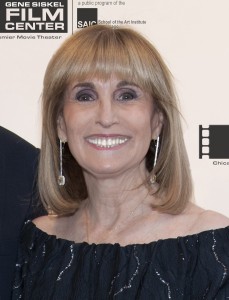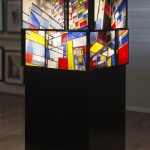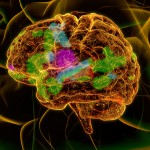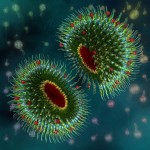
Oceans of Change, a piece by Ellen Sandor, Fermilab’s 2016 artist-in-residence, with other artists. Photo courtesy of Ellen Sandor.

Chicago artist Ellen Sandor, Fermilab’s 2016 artist-in-residence and founder of the collaborative group (art)n. Photo courtesy of Ellen Sandor.
Chicago artist Ellen Sandor, founder and director of the collaborative artists group (art)n, has been chosen as Fermi National Accelerator Laboratory’s artist-in-residence for 2016.
Sandor has spent her 40-year career visualizing the invisible, using a unique combination of tools and materials to create vivid portraits of microscopic organisms, or to show the effects of time on world landmarks. For the next year, Sandor will spend time with researchers at the U.S. Department of Energy’s Fermilab – who use massive instruments to visualize invisible subatomic particles – and will create several new works inspired by the extraordinary science happening at the suburban Chicago laboratory, using the latest new media technology.
“My goal, as always, is to create pieces that are scientifically correct as well as classically beautiful as a work of art,” Sandor said. “I’m excited to get started.”
Sandor is perhaps best known as the inventor of a new artistic medium called PHSColograms. These three-dimensional pieces combine photography, holography, sculpture and computer graphics to create immersive experiences. Sandor and her team of collaborators have used this patented process to visualize everything from the Ebola virus to architectural renderings of buildings that were planned but never constructed.
Sandor’s early work with PHSColograms was on display at Fermilab in 1987. Included in that show was Sandor’s 3-D portrait of the AIDS virus, one of the first attempts to scientifically visualize the organism behind that disease. The Fermilab Art Gallery also features a piece by Sandor’s long-time friend, the late Martyl Langsdorf, on permanent display.
“I visited the laboratory in the 1980s with Martyl, and since then have been reading about the wonderful things happening there,” Sandor said. “It will be an honor for me to work with the scientists at Fermilab, who are truly rock stars.”
Fermilab’s artist-in-residence program was inaugurated in 2014, and offers artists a chance to create work based on Fermilab’s experiments and research. Artists interview scientists and tour research areas of the facility, and create new works based on what they learn. They then serve as an ambassador to the arts community, inviting them to look at the science of particle physics from a new, more resonant perspective.
Oak Park artist Lindsay Olson will wrap up her term as the laboratory’s first artist-in-residence in December. Olson, who works in a variety of artistic media, produced more than a dozen new works inspired by Fermilab’s science, some of which can be seen online.
“We’re very pleased to have Ellen Sandor on board to continue our artist-in-residence program,” said Georgia Schwender, curator of the Fermilab Art Gallery. “This program offers people another way to understand physics, through the eyes of artists who can interpret Fermilab’s science in compelling ways.”
Fermilab is America’s premier national laboratory for particle physics and accelerator research. A U.S. Department of Energy Office of Science laboratory, Fermilab is located near Chicago, Illinois, and operated under contract by the Fermi Research Alliance LLC. Visit Fermilab’s website at www.fnal.gov and follow us on Twitter at @Fermilab.
The Fermi Research Alliance is a partnership between the University of Chicago and the Universities Research Association that manages Fermilab for the U.S. Department of Energy Office of Science. FRA manages the laboratory through its Board of Directors, which consists of two dozen academic and industry leaders who guide the operation and scientific directions of Fermilab.
- An example of a PSCHologram on display, created by Ellen Sandor, Fermilab’s 2016 artist-in-residence, with other artists. Photo courtesy of Ellen Sandor.
- (Brain + Love) Left, a piece by Ellen Sandor, Fermilab’s 2016 artist-in-residence, with other artists. Photo courtesy of Ellen Sandor.
- The Magnificent Micelle, Detail III, a piece by Ellen Sandor, Fermilab’s 2016 artist-in-residence, with other artists. Photo courtesy of Ellen Sandor.






